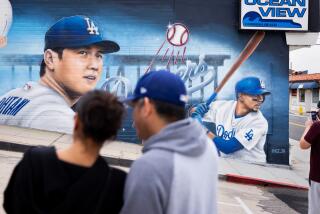Henry Ohye; Pioneer Flier, Led Japanese-Americans
- Share via
Henry Ohye, a Japanese-American businessmen and flying enthusiast who spent many of the middle years of his life helping to restore luster to the tarnished image his race suffered in the aftermath of World War II, is dead at age 77.
Ohye, founder of the Japanese American Aeronautics Assn., in 1964 became the first Nisei to cross the Pacific in a single-engine airplane. He died May 12 at a hospital in Northridge.
In 1950, Ohye, a retired automobile dealer, established what since has evolved into a pilots’ proficiency test for all fliers, regardless of racial background. Originally, the Henry Ohye Trophy Race was limited to four Japanese-American fliers racing from Los Angeles to Chicago, for at that time pilots of Japanese ancestry had to compete among themselves. They were not allowed to be military or commercial pilots.
Ohye began the competition out of his own aviation frustrations. He made his first solo flight in 1931 after pinching the few pennies he earned as a boy in Watsonville, Calif., and spending them on flying lessons. Two years later he earned his commercial license.
But “discrimination was severe even then,” he told The Times in a 1979 interview. Although he was eligible to be a commercial pilot, none of the airlines would hire him.
“I turned down offers to fly in Japan,” Ohye said. “I had no interest in military flying.”
To keep his hand in aviation he opened a flying school at Mines Field--later to become Los Angeles International Airport--and with other Japanese-American pilots participated in local air shows to offset the growing anti-Japanese sentiment of the late 1930s.
Feelings were running so strong at the time, he recalled, that he blamed sabotage when a parachute was packed incorrectly and nearly cost him his life in a demonstration jump.
After the Japanese attack on Pearl Harbor in 1941, Ohye tried to join the Army Air Corps, but he was rejected because of his race. Instead he and his family were sent to a relocation camp in Arizona, where he organized model airplane-building classes for boys.
In July, 1964, after taking off from Los Angeles and stopping in Oakland, Honolulu, Midway, Wake, Guam and Okinawa, Ohye landed his single-engine Piper Comanche in Tokyo to become the first Japanese-American to accomplish that feat. (Masaichi Goto of Los Angeles died trying it in 1929.)
Thereafter Ohye became a symbol of resurrection to the once-beleaguered Japanese community here, saying modestly, “I have been fortunate in being able to do what I wanted to do for no monetary profit.”
More to Read
Sign up for Essential California
The most important California stories and recommendations in your inbox every morning.
You may occasionally receive promotional content from the Los Angeles Times.










